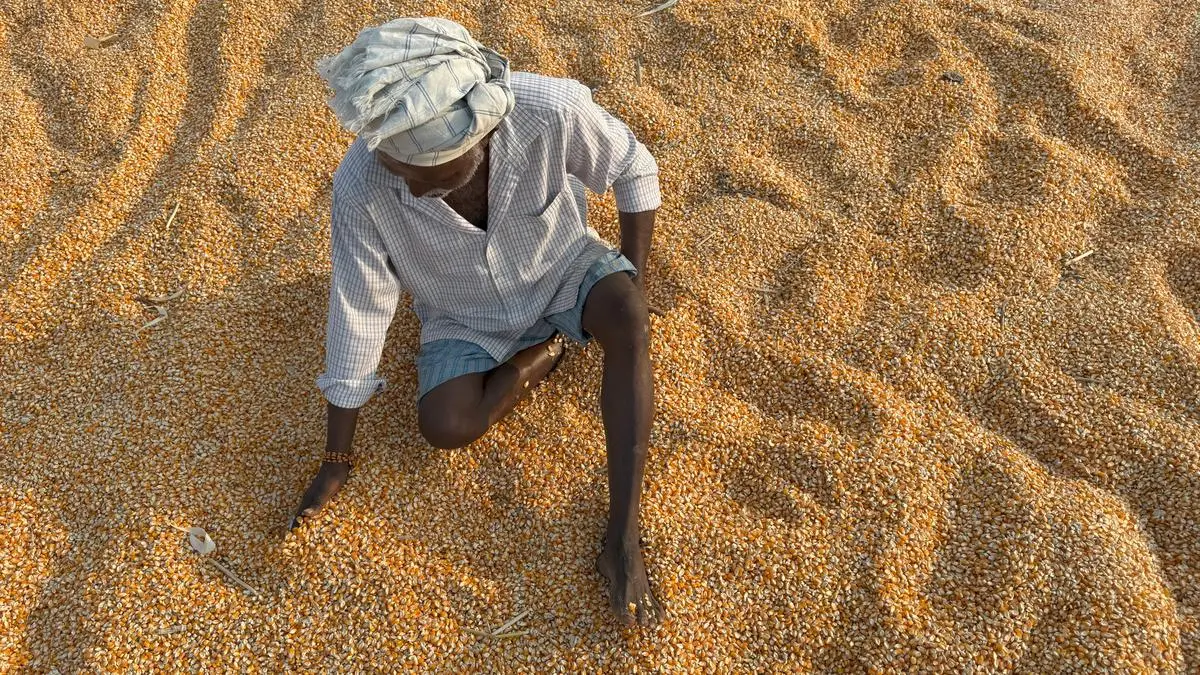
Across India, farmers face mounting challenges—from erratic weather and soil degradation to pest infestations and volatile input costs.
| Photo Credit:
RAO GN
As global food systems evolve, India’s agricultural future depends not just on growing more, but on growing smarter. The path from farmer to food processor represents a powerful shift: one that can unlock economic resilience, create rural jobs and strengthen climate adaptation at the grassroots.
Yet this transformation must begin by addressing the ground realities.
Farming in transition
Across India, farmers face mounting challenges—from erratic weather and soil degradation to pest infestations and volatile input costs. Over half still operate without basic mechanisation, and nearly 75 per cent remain deeply vulnerable to climate disruptions.
These are not just gaps in infrastructure, but in access to timely crop advisory, soil health data, storage and markets. Fertiliser is applied without testing. Pest outbreaks go unmanaged. High-value crops perish post-harvest due to the absence of cold chains or processing units.
To truly enable value addition, we need more than innovation—we need integration. Localised, affordable solutions must be delivered through trusted networks, backed by training, financing and strong market linkages. By reimagining the farm as more than a place of production—as a hub of processing, packaging and entrepreneurship—we can transform farmers into value creators and build a more resilient rural economy.
Integrated farm solutions: Tools for every stage
Integrated farm solutions tailored to local geographic and environmental contexts can serve as powerful enablers for smallholder resilience. From pre-sowing to post-harvest, the emphasis must shift towards climate-smart interventions that enhance yield while building long-term sustainability.
Pre-sowing: Services like soil testing, combined with customised agronomic advisory, can help farmers avoid blanket fertilisation practices—lowering input costs and improving productivity.
Production: Solutions such as solar-powered pumps and borewell recharging systems address water scarcity, while mechanization—delivered through custom hiring centres—offers smallholder farmers access to tools on a pay-per-use basis.
Post-harvest: Investment in post-harvest infrastructure like solar dryers, quality testing kits and cold storage is critical to reducing spoilage and enabling farmers to access better prices through stronger market linkages.
In drought-prone regions, borewell recharging has emerged as a scalable solution to groundwater depletion. Meanwhile, in flood-prone areas, resilient cropping patterns and bio-inputs are helping farmers protect plant health from excessive moisture and disease pressures.
A localised approach to value creation
Technology deployment alone is insufficient. A farm innovation ecosystem must focus on enabling adoption and scaling through three critical enablers:
1. Market Channel Building: Stronger connections between innovations and Farmer Producer Organisations (FPOs) can help ensure demand-driven adoption. In many cases, FPOs also facilitate buy-back arrangements—helping farmers secure a steady income.
2. Capacity Building: Field demonstrations and training initiatives can bridge behavioural gaps by showing farmers tangible benefits and encouraging peer learning within farmer communities.
3. Innovative Financing: A combination of rental models, end-user credit and direct financing mechanisms can help overcome affordability barriers, ensuring equitable access to essential innovations.
Incubators are driving this shift by supporting grassroots innovators, connecting them with FPOs, enabling last-mile delivery and designing financing and training models tailored to local needs, ensuring that innovation translates into real impact for smallholder farmers.
Impact in action: Evidence from the field
In practice, integrated, ecosystem-based approaches are showing measurable outcomes. In multiple regions, farmers using soil health advisory services have reported significant improvements in yield and reductions in input expenses due to more efficient resource use.
Building on this, a survey of 4,000 farmers who accessed Villgro-supported soil testing services through their respective FPOs found that 83 per cent reported a 10 per cent increase in yield and a 17 per cent reduction in input costs.
In areas like Uttar Pradesh and Bihar, where erratic electricity has long hindered irrigation, solar-powered pumps can enable daily irrigation of over 1 lakh liters per farm. The impact of water interventions include more water availability for irrigation and better water quality for farmers planning to cultivate one more season.
From growers to value creators
Post-harvest value addition—through drying, grading, processing or packaging—has the potential to double or triple the income earned from a crop. However, smallholders often lack access to the infrastructure and markets needed to unlock this potential.
Decentralised processing units, solar dryers and climate-resilient cold chains are critical tools that can help extend shelf life and open new markets, including export opportunities. As India sees rising demand for clean-label, processed and climate-conscious food, integrating smallholders into these value chains becomes both an economic and strategic imperative.
Conclusion: The future of rural resilience
India’s agricultural future lies not in intensifying production alone, but in empowering farmers to move up the value chain—from growers to processors to entrepreneurs. Localised, affordable innovations—when supported by strong market access, capacity-building and financing—can lay the foundation for systemic change.
The vision for Indian agriculture must now center around economic diversification at the grassroots level. A farmer who can also process, package and sell value-added products is more than a cultivator—they become a cornerstone of rural economic resilience.
The author is Chief Executive Officer, Villgro
Published on April 13, 2025
Anurag Dhole is a seasoned journalist and content writer with a passion for delivering timely, accurate, and engaging stories. With over 8 years of experience in digital media, she covers a wide range of topics—from breaking news and politics to business insights and cultural trends. Jane's writing style blends clarity with depth, aiming to inform and inspire readers in a fast-paced media landscape. When she’s not chasing stories, she’s likely reading investigative features or exploring local cafés for her next writing spot.






